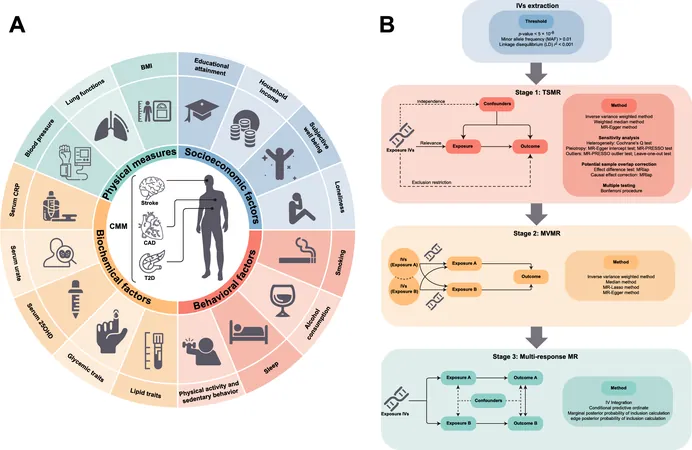
Unlocking the Secrets of Cardiometabolic Multimorbidity: How Modifiable Factors Can Change Your Health
2025-06-06
Author: Yu
Understanding Cardiometabolic Multimorbidity
Cardiometabolic multimorbidity (CMM) refers to the coexistence of two or more cardiometabolic diseases (CMDs), such as type 2 diabetes (T2D), coronary artery disease (CAD), and stroke. A groundbreaking study has examined how modifiable factors affect the development of CMM, shedding light on potential prevention strategies.
An In-Depth Analysis of Modifiable Factors
Researchers systematically collected data from genome-wide association studies (GWAS), focusing on 35 modifiable factors categorized into socioeconomic, behavioral, biochemical, and physical measures. This comprehensive approach sampled over 367,000 individuals, enabling a robust analysis of causal relationships between these factors and CMM.
Insights from Genetic Studies
The study utilized advanced techniques, including Mendelian randomization, to explore causal associations. It revealed that higher educational attainment and household income significantly reduce the risk of CMM and individual CMDs. For instance, individuals with higher education had an odds ratio (OR) of 0.858 for CMM, indicating a lower risk.
Physical Activity's Powerful Role
Physical activity emerged as a crucial protective factor. Moderate to vigorous exercise correlated with lower risks of CMM (OR: 0.690) and T2D (OR: 0.666). Conversely, high leisure screen time and smoking increased the likelihood of developing CMM and other CMDs.
Biochemical and Physical Measures Matter
Biochemical markers also play a role. Higher levels of beneficial cholesterol (HDL) were linked to reduced risks, while elevated triglycerides increased them. Among physical measures, better lung function (FEV1) demonstrated a protective effect against CMM.
The Causal Chain Unveiled
The research identified 13 key factors that robustly influence CMM after accounting for multiple testing, highlighting the need for targeted interventions in education, lifestyle changes, and health management.
Transforming Findings into Action
The implications of this study are profound. To tackle CMM, public health policies should prioritize education, promote physical activity, and create environments that facilitate healthful behaviors. Enhanced screenings and tailored recommendations could significantly mitigate the risk of CMDs and improve overall population health.
Looking Ahead: The Future of Cardiometabolic Health
With modifiable factors being critical in shaping health outcomes, ongoing research will continue to explore these associations, particularly in diverse populations. Understanding and addressing the interconnectedness of socioeconomic, behavioral, and physical health factors will be vital in the fight against CMM and related diseases.


 Brasil (PT)
Brasil (PT)
 Canada (EN)
Canada (EN)
 Chile (ES)
Chile (ES)
 Česko (CS)
Česko (CS)
 대한민국 (KO)
대한민국 (KO)
 España (ES)
España (ES)
 France (FR)
France (FR)
 Hong Kong (EN)
Hong Kong (EN)
 Italia (IT)
Italia (IT)
 日本 (JA)
日本 (JA)
 Magyarország (HU)
Magyarország (HU)
 Norge (NO)
Norge (NO)
 Polska (PL)
Polska (PL)
 Schweiz (DE)
Schweiz (DE)
 Singapore (EN)
Singapore (EN)
 Sverige (SV)
Sverige (SV)
 Suomi (FI)
Suomi (FI)
 Türkiye (TR)
Türkiye (TR)
 الإمارات العربية المتحدة (AR)
الإمارات العربية المتحدة (AR)